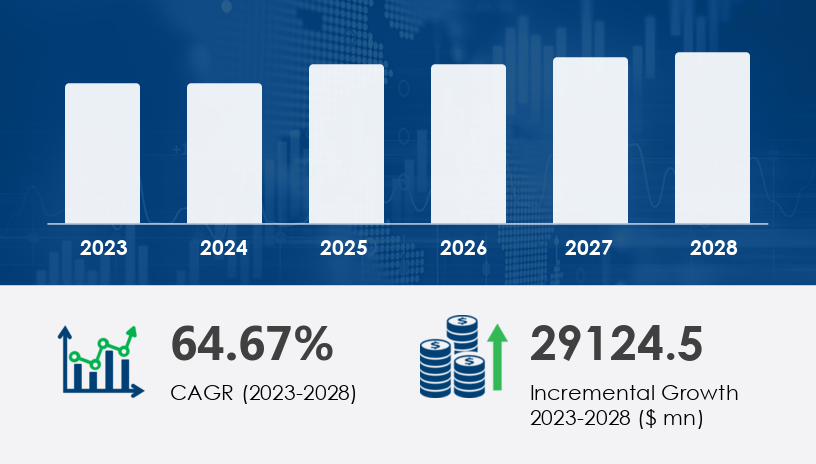The hyperloop technology market is entering a pivotal phase. Forecasts show explosive growth—USD 29.12 billion increase at a CAGR of 64.67% between 2023 and 2028. With the demand for ultra-fast, sustainable transportation rising globally, especially in emerging economies, this once-futuristic concept is fast becoming a commercial reality. This 2025 outlook provides strategic insights into the key forces shaping the hyperloop industry—from infrastructure challenges to technological breakthroughs—backed by exclusive data and industry commentary.
For more details about the industry, get the PDF sample report for free

Hyperloop is a next-generation transportation system that propels passenger or cargo pods through vacuum-sealed tubes at speeds reaching up to 760 mph (1,223 km/h). The design minimizes air resistance and friction using magnetic levitation and low-pressure environments, enabling unprecedented travel speed and efficiency.
The Hyperloop Technology Market is gaining momentum as a revolutionary solution for high-speed travel and sustainable transportation. Based on magnetic levitation and electric propulsion, Hyperloop systems use passenger pods and cargo pods that travel through low-pressure vacuum tubes, enabling ultra-fast intercity and intracity travel. With a near-vacuum environment and pod levitation facilitated by air bearings and electromagnetic motors, the technology promises drastically reduced travel time and carbon emissions, positioning itself as an eco-friendly transport alternative. The tube infrastructure, typically made of steel tubes, supports the aerodynamic capsule design and integrates smart sensors and safety systems, including emergency exits, to ensure passenger safety. Pilot projects and feasibility studies are underway globally, examining factors such as infrastructure costs, land acquisition, and regulatory approvals for widespread adoption of this high-capacity transport method.
See What’s Inside: Access a Free Sample of Our In-Depth Market Research Report.
The hyperloop technology market is segmented according to mode of transportation, distribution channel, and geography.
The tube segment is the backbone of hyperloop systems and is expected to see significant growth, largely due to its low-energy profile and underground adaptability. Each system uses side-by-side welded steel tubes, with solar arrays on top to supplement power needs.
Growth Drivers:
Energy efficiency
Minimal surface disruption
Scalability in both urban and remote geographies
Passenger transport remains the dominant segment, driven by public interest in reducing commute times across megacities.
Freight transport is gaining traction as businesses explore ways to cut shipping time and carbon emissions across supply chains.
Case Example:
Imagine a freight company reducing Los Angeles to San Francisco delivery from 8 hours to under 45 minutes—hyperloop could make this standard.
With 38% of global growth, North America—particularly the U.S.—is a hyperloop innovation hotspot. Investments from firms like Virgin Hyperloop, along with policy support from federal and state governments, are accelerating regional development.
Recent government initiatives aim to regulate and fund interstate hyperloop corridors, positioning North America as the global leader.
Hyperloop’s average speeds of 600+ mph make it faster than commercial flights on short-haul routes. This demand is especially pronounced in densely populated regions plagued by traffic congestion and flight delays.
Hyperloop systems operate with minimal emissions. Many models integrate solar-powered systems and magnetic propulsion, aligning with ESG targets and net-zero commitments.
As cities like Mumbai, Shanghai, and São Paulo modernize, hyperloop provides a scalable solution to overcrowded public transport systems. Their investment potential is now backed by improved urban planning and foreign partnerships.
The estimated cost per mile of hyperloop systems is USD 25–27 million, not including land acquisition. This makes funding and ROI justification critical challenges for stakeholders.
Maintaining a near-vacuum environment across hundreds of miles demands constant power. Any technical failure could result in significant safety hazards. Innovations are underway, but large-scale testing is still needed.
Partnerships with solar and energy companies are enabling green hyperloop corridors. A recent 2024 collaboration aims to make upcoming routes fully solar-powered, lowering operational costs and emissions.
Major players are merging with aerospace and infrastructure firms to accelerate tech development. The acquisition of a hyperloop propulsion startup by a global aerospace firm in late 2024 is expected to fast-track commercialization.
Analysis of the Hyperloop market highlights the role of innovative features such as autonomous control, real-time monitoring, and pod scalability in driving adoption. Freight transport capabilities are being evaluated for congestion relief and improved urban mobility, particularly in smart cities where sustainable travel solutions are in high demand. Emphasis on energy efficiency is evident with many systems designed to operate using renewable energy sources like solar power, reducing dependency on fossil fuels. The aerodynamic pod design is optimized for high speeds while maintaining passenger comfort and safety. Moreover, addressing traffic congestion and improving connectivity are central goals of ongoing projects. As companies refine capsule aerodynamics and safety protocols, Hyperloop is expected to become a viable alternative to conventional transport, merging speed, sustainability, and scalability for the future of mobility.
Get more details by ordering the complete report
Public-Private Synergies: Governments must incentivize early-stage hyperloop infrastructure via grants and regulatory support.
Corporate Foresight: Companies in logistics, construction, and clean tech should position now for partnerships or licensing opportunities.
Urban Transformation: Cities with congestion challenges can benefit from planning hyperloop corridors as part of smart city initiatives.
By 2028, hyperloop technology could redefine both regional travel and global logistics. If technical hurdles are overcome, expect:
Intercity travel times reduced by 70–90%
Cargo shipping routes connecting ports to inland hubs in minutes
Entire logistics ecosystems reorganized around hyperloop terminals
| Strategic Focus | Recommended Action |
|---|---|
| Infrastructure Developers | Form alliances with hyperloop OEMs to gain early access |
| Investors | Target companies in propulsion, vacuum tech, and materials science |
| Governments | Fast-track pilot approvals and incentivize R&D |
| Corporates (Retail/Logistics) | Prepare for freight hyperloop integration within 3–5 years |
Safe and Secure SSL Encrypted